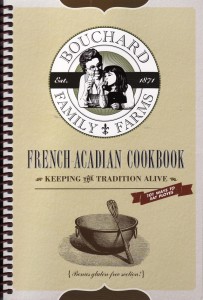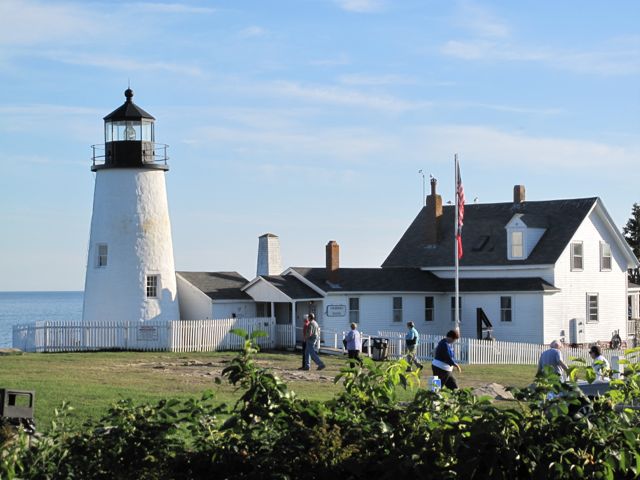
Ployes! Pot en Pot! Tortierre! Creton! Raisin Pie! If you’ve ever had the good fortune to travel in Maine’s St. John Valley, you’re likely familiar with French-Acadian cuisine. Bouchard Family Farms, based in Fort Kent, Maine, has a new cookbook, French-Acadian Cookbook: Keeping the Tradition Alive ($12), that celebrates both the food and Maine’s Acadian culture (see my previous post on ployes and Acadians).
Bouchard is known for its ployes mix, which is made from buckwheat grown and milled on the family farm. I buy it and make ployes often, usually for breakfast, although thanks to this new cookbook, I now have 101 ways to use the mix, from making pancakes to as a coating for fried fish.
Equally enticing recipes include Acadian-style baked beans, French-Acadian doughnuts, pea soup, chicken stew, and herbs salees (salted onions—so glad to have the recipe, as I purchased a jar of these during my last visit to The County and have used them in everything from eggs to soup). There are recipes for Maine potato donuts, salmon shepherd’s pie, even a recipe for the World’s Best Whoopie Pies.
Traditionally, ployes were served as the bread with every meal. With that in mind, consider these recipes—hearty fare for a cold winter’s night.
NOTE: Bouchard Family Farms ployes mix is, fat free, cholesterol free, and vegan. Good stuff!
French-Acadian recipes
Pot en Pot
Although this main dish can be served anytime, it was an anticipated treat at Christmas and New Year’s during family gatherings.
Filling:
2 pounds beef
2 pounds pork
2 pounds chicken
2 large chopped onions
2.5 teaspoons summer savory
salt & pepper to taste
Dumplings
2 cups flour
1 teaspoon salt
1/2 cup Crisco
cold water
Preparation
Dumplings: Sift flour and salt in medium-sized bowl and cut in Crisco with fork or pastry blender. Add cold water, enough to mke a very thick dough. Turn dough on floured board and roll to 1/4-inch thick. Cut one round crust for top of pot and rest into 1-inch-sized pieces.
Meat filling: Cut all meat into 1-inch squares and mix together. In a 4-quart pot, place about 1 inch of mixed meat, salt and pepper, and 1 teaspoon summer savory. Add 1/3 of the chopped onions. Place some cut-up dumpling over this first layer of meat. Repeat with a second layer of meat, seasonings, and dumplings. Repeat with the third layer but top with the round crust. Cut slits in the crust to vent. Gently lift part of the crus and add cold water to just cover the top of the meat, then replace crust. Cover and bake at 350 degrees for 3 hours, then turn down oven to 275 degrees and bake for an additional 2 h ours. Remove cover for last 1/2 hour to brown crust.
Serves: ~10. (For a larger crowd, double recipe, but add an additional hour of cooking time at 275 degrees).
Tourtiere (French-Acadian meat pie)
This is another traditional French-Acadian recipe for Christmas Eve or New Year’s Eve. There were many different variations to this and most recipes. Everyone’s grandmother had the best one.
1/2 pound ground beef
1/2 pound ground pork
1 small chopped onion
1 clove minced garlic
3/4 cup water
1 finely chopped celery ribbed
1 finely chopped carrot
3 cubes chicken bouillon
1 finely chopped potato
1/4 teaspoon black pepper
1/4 teaspoon cinnamon
1/8 teaspoon nutmeg
9-inch unbaked deep-dish pie shell with top crust
1 egg yolk
1 tablespoon water
Preheat oven to 350 degrees. Brown beef and pork with onion and garlic in a large skillet. Drain. Stir in 3/4 cup water, celery, carrot, potato, and bouillon cubes. Simmer for 10 minutes over medium heat. Stir pepper, cinnamon, and nutmeg into skillet mixture. Spoon mixture into deep-dish pie shell. In a small bowl, combine egg yolk and 1 tablespoon water to make egg wash: brush edge of crust with egg wash. Carefully add top crust and seal edges. Make slits in crust. Brush with remaining egg wash and bake for 45 minutes until golden brown.
Serves: 6.
Old Fashion Raisin Pie
Recipe by “Uncle Royden Paradis, King of Cooks” who spent many years cooking in Northern Maine lumber camps.
2 cups raisins
2 cups water
1/2 cup packed brown sugar
2 tablespoons cornstarch
1/2 teaspoon cinnamon
1/4 teaspoon salt
1 tablespoon vinegar
1 tablespoon butter or margarine
1 double unbaked pie shell with top crust or lattice strips
Combine raisins and water. Boil for 5 minutes. Blend brown sugar, cornstarch, cinnamon, and salt and add to raisin liquid (may remove small amount of liquid and blend with brown sugar, cornstarch, cinnamon, and salt. Add to raisins; will blend more smoothly). Cook and continue stirring until mixture thickens, about 10-15 minutes. Remove from heat and stir in vinegar and butter or margarine. Cool slightly, and pour into pastry-lined pan. Cover with top crust or lattice strips. Bake at 425 degrees for 25-30 minutes or until crust is golden brown.
Serves: 8













[…] Check out my review with recipes of the Bouchard Family Farms French-Acadian Cookbook: Keeping the Tradition […]
Eager to try this pot en pot recipe! Thank you!
Just wanted to clarify something, the ploye mix is not gluten free, just the straight buckwheat flour. Ployes are mixed with wheat flour just wanted you to know.
Thanks, I made the correction. Love your ployes mix!
I grew up in Van Buren, Maine along the St John Valley River. My father used to make a ” salted” onions in a large mason jar. I believe the French name was ” Daisy-shallot” accent on shallot. in any case I can’t remember how he made it but I think he would take the shallot ( pearl) onion bulb and place in a large mason jar and added kosher salt ( absolutely no water) and maybe pickling salt??? Anyway has anyone heard of this and what is the recipe. I am embarrassed to say I did not write his recipe down. Any help would be appreciated.
Sounds like herbs salees, which is green onions and sea salt. You might check with Bouchard Farm.
Shawn, your are speaking not of herbs salees, but of Eschalots. You father would have called them “Des Eschalots” which sort of sounds like “daisy shallots.” They are a variety of young french shallot that was brought over by Acadians. They are traditionally planted in the late summer to fall, over wintered an harvested in the spring (usually late May and June). The green tops are set a side and can be used to make salted herbs, but the eschalots (white bulbs) are cut from the root, peeled, cleaned in cool water bath and pickled in a salt brine (usually in a jar of some type). To make them I pack a jar full of eschalots, add 2 heaping table spoons of non-iodized salt, and fill the jar with water. They usually are “ready” within 2-3 days. Properly salted they can last up to a few months, but usually are eaten much quicker. Note they are planted from a bulb as they do not go to seed, so hope you have good family connections for the right seed bulbs!
Comments are closed.